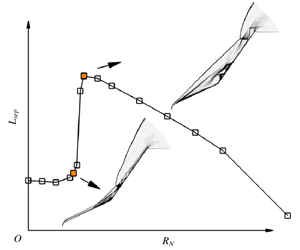Published online by Cambridge University Press: 05 June 2020

A hypersonic shock wave/laminar boundary-layer interaction over a canonical  $25{-}55^{\circ }$ double-cone configuration is numerically investigated. A moderate-enthalpy flow of
$25{-}55^{\circ }$ double-cone configuration is numerically investigated. A moderate-enthalpy flow of  $5~\text{MJ}~\text{kg}^{-1}$ with a Mach number of 9.87 and a unit Reynolds number of
$5~\text{MJ}~\text{kg}^{-1}$ with a Mach number of 9.87 and a unit Reynolds number of  $1.5\times 10^{5}~\text{m}^{-1}$ is considered. Special emphasis is given to the influence of leading-edge bluntness. The results indicate that the double-cone flow is insensitive to small bluntness in terms of shock structures, separation region sizes and surface pressure and heat flux distributions. A critical nose radius is observed, beyond which the separation bubble grows dramatically. The numerical data are analysed and interpreted based on a triple-deck formulation. It is shown that the sudden change in flow features is mainly caused by pressure overexpansion on the first cone due to leading-edge bluntness, such that the skin friction upstream of the separation is significantly reduced and the upstream pressure can no longer resist the large adverse pressure gradient induced by shock impingement. An estimation of the critical radius is established based on the pressure correlations of Blick & Francis (AIAA J., vol. 4 (3), 1966, pp. 547–549) for spherically blunted cones. Simulations at a higher enthalpy with the presence of both vibrational relaxation and air chemistry show a similar trend with increasing nose radius. The proposed criterion agrees well with the experimental observations.
$1.5\times 10^{5}~\text{m}^{-1}$ is considered. Special emphasis is given to the influence of leading-edge bluntness. The results indicate that the double-cone flow is insensitive to small bluntness in terms of shock structures, separation region sizes and surface pressure and heat flux distributions. A critical nose radius is observed, beyond which the separation bubble grows dramatically. The numerical data are analysed and interpreted based on a triple-deck formulation. It is shown that the sudden change in flow features is mainly caused by pressure overexpansion on the first cone due to leading-edge bluntness, such that the skin friction upstream of the separation is significantly reduced and the upstream pressure can no longer resist the large adverse pressure gradient induced by shock impingement. An estimation of the critical radius is established based on the pressure correlations of Blick & Francis (AIAA J., vol. 4 (3), 1966, pp. 547–549) for spherically blunted cones. Simulations at a higher enthalpy with the presence of both vibrational relaxation and air chemistry show a similar trend with increasing nose radius. The proposed criterion agrees well with the experimental observations.
To send this article to your Kindle, first ensure no-reply@cambridge.org is added to your Approved Personal Document E-mail List under your Personal Document Settings on the Manage Your Content and Devices page of your Amazon account. Then enter the ‘name’ part of your Kindle email address below. Find out more about sending to your Kindle. Find out more about saving to your Kindle.
Note you can select to save to either the @free.kindle.com or @kindle.com variations. ‘@free.kindle.com’ emails are free but can only be saved to your device when it is connected to wi-fi. ‘@kindle.com’ emails can be delivered even when you are not connected to wi-fi, but note that service fees apply.
Find out more about the Kindle Personal Document Service.
To save this article to your Dropbox account, please select one or more formats and confirm that you agree to abide by our usage policies. If this is the first time you used this feature, you will be asked to authorise Cambridge Core to connect with your Dropbox account. Find out more about saving content to Dropbox.
To save this article to your Google Drive account, please select one or more formats and confirm that you agree to abide by our usage policies. If this is the first time you used this feature, you will be asked to authorise Cambridge Core to connect with your Google Drive account. Find out more about saving content to Google Drive.